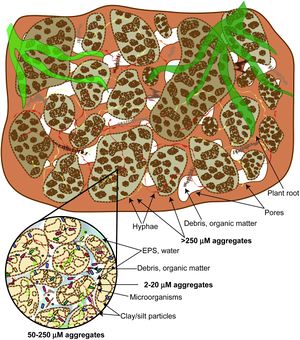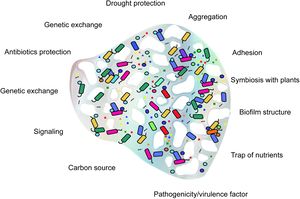Carbon-14

Overview
Uses

Tree Ring Dating
The suspected primary role of EPS is to create stable habitat bound to a desired substrate[2]. EPS is the matrix structure of biofilms. Biofilms are very effective at retaining water in soils even with very negative water potentials.[3] This allows microbes to resist desiccation during drought periods. EPS can also stabilize pH and reduce the amount of nutrients lost to runoff by binding to them.
Carbon-14 Tracing
EPS provides a stable interface for soil microbes to chemically work on attached substrate and suspended materials. In addition EPS can act as a store of carbon and other nutrients. The binding nature of EPS also helps reduce nutrient loss in soils from runoff.[4]

Hydrology
EPS affects evaporation and flow of water directly and through alterations to the functional soil structure. EPS resists evaporation and slows flow by absorbing and binding water tightly. Also, the biofilm structures formed with EPS can cause bioclogging of pores which blocks evaporation and mass flow of water by reducing the hydraulic conductivity[6][3]. This slows the overall rate of change in soil moisture content making for a more stable environment.
Soil Structures
EPS production fills pore space which reduces the effective porosity of the soil. Also, the swelling shrinking actions of EPS water intake and loss can alter the pore space but there remains a lack of literature differentiating this effect in bulk soil[6]. EPS plays a key role in soil aggregate formation by working as a cementing agent. This has the added effect of reducing soil slaking and increasing overall stability. This added stability can lower erosion rates and decrease nutrient runoff.
Plants
EPS play a role in holding microbes to roots or in the rhizosphere and act as the medium for symbiotic microbes to exchange nutrients in exchange for root exudates[5]. The microbes, through the effects of EPS and release of nutrients, stimulate the the exudate release by the roots which introduces fresh carbon sources to the rhizosphere. There is also evidence to suggest EPS assists in salinity tolerance for some plants.[7]
Agriculture
There is growing interest in using EPS producing bacteria in agricultural settings. EPS improves soil particle aggregation which is an issue common to traditional agricultural practices in may parts of the world. Also, EPS producing bacteria improve nutrient availability to plants, increase water stability, and stimulate root growth.[5]
Analysis methods
Cation exchange resin (CER) extraction is currently considered the best method for accurately extracting EPS from soils.[8]This method shows the highest efficency with the least amount of modification to the original EPS composition when compared to other methods. This method works by replacing cations in the material being sampled. This destabilizes the structure and allows for separation through filtration and/or centrifuge.
References
- ↑ Aalexopo, https://commons.wikimedia.org/wiki/File:Biofilm_Formation.jpg.CC BY-SA 3.0
- ↑ Cite error: Invalid
<ref>tag; no text was provided for refs namedFlemming_2016 - ↑ 3.0 3.1 Cite error: Invalid
<ref>tag; no text was provided for refs namedOr_2007 - ↑ Lin, D., Ma, W., Jin, Z., Wang, Y., Huang, Q., Cai, P., 2016. Interactions of EPS with soil minerals: A combination study by ITC and CLSM. Colloids and Surfaces B: Biointerfaces 138, 10–16. https://doi.org/10.1016/j.colsurfb.2015.11.026
- ↑ 5.0 5.1 5.2 Cite error: Invalid
<ref>tag; no text was provided for refs namedCosta_2018 - ↑ 6.0 6.1 Cite error: Invalid
<ref>tag; no text was provided for refs namedDeng_2015 - ↑ Ashraf, M., Hasnain, S., Berge, O., Mahmood, T., 2004. Inoculating wheat seedlings with exopolysaccharide-producing bacteria restricts sodium uptake and stimulates plant growth under salt stress. Biol Fertil Soils 40. https://doi.org/10.1007/s00374-004-0766-y
- ↑ Redmile-Gordon, M.A., Brookes, P.C., Evershed, R.P., Goulding, K.W.T., Hirsch, P.R., 2014. Measuring the soil-microbial interface: Extraction of extracellular polymeric substances (EPS) from soil biofilms. Soil Biology and Biochemistry 72, 163–171.